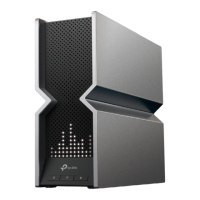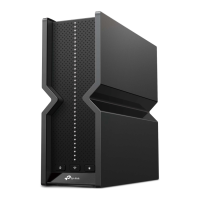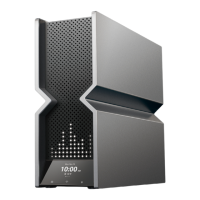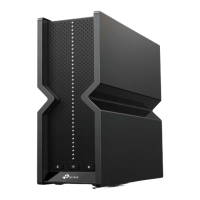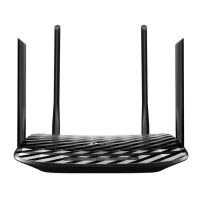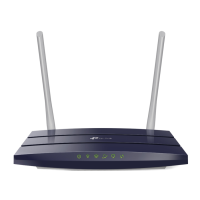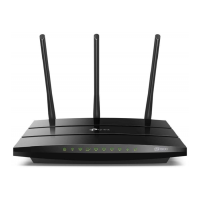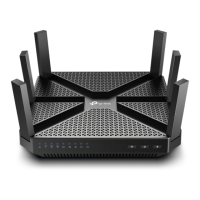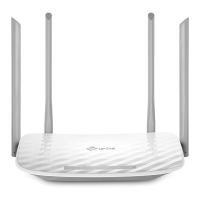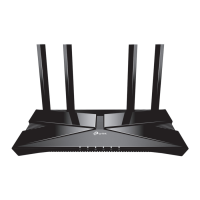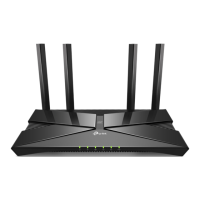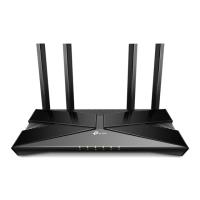Do you have a question about the TP-Link Archer BE805 and is the answer not in the manual?
Explains the features and benefits of the Wi-Fi 7 router.
Details the front and back panel components and LED indicators.
Provides guidelines on optimal placement for router performance and safety.
Guides through the physical connection steps for modem and computer.
Instructions on accessing the router's web management interface.
Step-by-step guide for initial internet connection setup.
Setup instructions using the TP-Link mobile application.
Detailed guide for manual internet connection configuration.
Configuration to use the router in Access Point mode.
Steps to configure an IPv6 internet connection.
Instructions for creating a TP-Link account for remote management.
Guide to updating email address and password for TP-Link ID.
How to add or remove TP-Link IDs for router management.
Using the Tether app for router management on mobile devices.
Outlines device connectivity and network settings management.
Customizing SSID, password, and security options for wireless networks.
Setting a schedule to automatically turn wireless networks on or off.
Guide to connecting devices using Wi-Fi Protected Setup (WPS).
Configuration of advanced wireless parameters like WMM, Airtime Fairness.
Steps to set up a separate Wi-Fi network for guests.
Adjusting permissions and settings for guest network access.
Securing the home network by creating a dedicated wireless network for IoT devices.
How to access files on a USB device connected to the router from a local network.
Steps to access USB storage from outside the local network via Internet FTP.
Monitoring USB storage usage and configuring device settings.
Customizing sharing settings, server names, and authentication for USB access.
Enabling DLNA media sharing for photos, music, and movies from USB storage.
Configuring router for Mac Time Machine backups to a USB storage device.
Analyzing and optimizing network performance and security.
Setting up restrictions, time limits, and content filters for family members.
Prioritizing network traffic for specific devices to ensure smooth performance.
Overview of additional security and management features available with HomeShield.
Steps to integrate another TP-Link router into an EasyMesh network.
Adding a range extender to boost Wi-Fi coverage within an EasyMesh network.
Viewing and managing mesh devices and connected clients.
Enabling SPI Firewall for protection against unauthorized access.
Blocking or allowing specific devices to access the network via MAC address.
Preventing ARP spoofing and attacks by binding IP to MAC addresses.
Configuring Application Layer Gateway settings for network protocols.
Isolating IoT devices to protect the network from potential security threats.
Allowing external access to specific services on the local network.
Dynamically opening external ports based on connection to triggering ports.
Exposing a device to the internet with all ports open for unrestricted communication.
Enabling Universal Plug and Play for seamless online game connectivity.
Setting up an OpenVPN server for secure remote access to the home network.
Configuring a PPTP VPN server for remote access, noting its security limitations.
Setting up L2TP/IPSec VPN for secure remote access, balancing security and speed.
Configuring a WireGuard VPN server for fast and secure remote access.
Configuring the router to connect to a remote VPN server.
Modifying internet connection type, MAC address, and NAT settings.
Adjusting the router's LAN IP address and subnet mask.
Combining network ports for higher bandwidth and stable wired connections.
Setting up the router for Internet/IPTV/Phone services using IGMP or VLAN.
Configuring DHCP server for dynamic IP assignment and IP address reservation.
Configuring DDNS for remote access using a domain name.
Manually configuring routing entries for specific network destinations.
Instructions for updating router firmware via auto, online, or local methods.
Remotely checking and updating firmware for EasyMesh satellite devices.
Saving router settings to a file and restoring them if needed.
How to change the password for the router's web management page.
Setting up a recovery mechanism for the forgotten router login password.
Limiting access to the router's management interface based on MAC address.
Enabling remote access to the router's management interface.
Saving and sending system logs for troubleshooting network issues.
Using Ping and Traceroute tools to diagnose network connectivity problems.
Configuring the router's system time and display language.
Scheduling automatic reboots to maintain router performance.
Enabling Night Mode to turn off router LEDs during specific hours.
Steps to recover or reset the wireless network password.
Procedures for resetting the router login password.
Troubleshooting steps for accessing the router's web interface.
Solutions for internet connectivity issues after configuration.
Troubleshooting steps for wireless network discovery and connection problems.
Explains the features and benefits of the Wi-Fi 7 router.
Details the front and back panel components and LED indicators.
Provides guidelines on optimal placement for router performance and safety.
Guides through the physical connection steps for modem and computer.
Instructions on accessing the router's web management interface.
Step-by-step guide for initial internet connection setup.
Setup instructions using the TP-Link mobile application.
Detailed guide for manual internet connection configuration.
Configuration to use the router in Access Point mode.
Steps to configure an IPv6 internet connection.
Instructions for creating a TP-Link account for remote management.
Guide to updating email address and password for TP-Link ID.
How to add or remove TP-Link IDs for router management.
Using the Tether app for router management on mobile devices.
Outlines device connectivity and network settings management.
Customizing SSID, password, and security options for wireless networks.
Setting a schedule to automatically turn wireless networks on or off.
Guide to connecting devices using Wi-Fi Protected Setup (WPS).
Configuration of advanced wireless parameters like WMM, Airtime Fairness.
Steps to set up a separate Wi-Fi network for guests.
Adjusting permissions and settings for guest network access.
Securing the home network by creating a dedicated wireless network for IoT devices.
How to access files on a USB device connected to the router from a local network.
Steps to access USB storage from outside the local network via Internet FTP.
Monitoring USB storage usage and configuring device settings.
Customizing sharing settings, server names, and authentication for USB access.
Enabling DLNA media sharing for photos, music, and movies from USB storage.
Configuring router for Mac Time Machine backups to a USB storage device.
Analyzing and optimizing network performance and security.
Setting up restrictions, time limits, and content filters for family members.
Prioritizing network traffic for specific devices to ensure smooth performance.
Overview of additional security and management features available with HomeShield.
Steps to integrate another TP-Link router into an EasyMesh network.
Adding a range extender to boost Wi-Fi coverage within an EasyMesh network.
Viewing and managing mesh devices and connected clients.
Enabling SPI Firewall for protection against unauthorized access.
Blocking or allowing specific devices to access the network via MAC address.
Preventing ARP spoofing and attacks by binding IP to MAC addresses.
Configuring Application Layer Gateway settings for network protocols.
Isolating IoT devices to protect the network from potential security threats.
Allowing external access to specific services on the local network.
Dynamically opening external ports based on connection to triggering ports.
Exposing a device to the internet with all ports open for unrestricted communication.
Enabling Universal Plug and Play for seamless online game connectivity.
Setting up an OpenVPN server for secure remote access to the home network.
Configuring a PPTP VPN server for remote access, noting its security limitations.
Setting up L2TP/IPSec VPN for secure remote access, balancing security and speed.
Configuring a WireGuard VPN server for fast and secure remote access.
Configuring the router to connect to a remote VPN server.
Modifying internet connection type, MAC address, and NAT settings.
Adjusting the router's LAN IP address and subnet mask.
Combining network ports for higher bandwidth and stable wired connections.
Setting up the router for Internet/IPTV/Phone services using IGMP or VLAN.
Configuring DHCP server for dynamic IP assignment and IP address reservation.
Configuring DDNS for remote access using a domain name.
Manually configuring routing entries for specific network destinations.
Instructions for updating router firmware via auto, online, or local methods.
Remotely checking and updating firmware for EasyMesh satellite devices.
Saving router settings to a file and restoring them if needed.
How to change the password for the router's web management page.
Setting up a recovery mechanism for the forgotten router login password.
Limiting access to the router's management interface based on MAC address.
Enabling remote access to the router's management interface.
Saving and sending system logs for troubleshooting network issues.
Using Ping and Traceroute tools to diagnose network connectivity problems.
Configuring the router's system time and display language.
Scheduling automatic reboots to maintain router performance.
Enabling Night Mode to turn off router LEDs during specific hours.
Steps to recover or reset the wireless network password.
Procedures for resetting the router login password.
Troubleshooting steps for accessing the router's web interface.
Solutions for internet connectivity issues after configuration.
Troubleshooting steps for wireless network discovery and connection problems.
| Brand | TP-Link |
|---|---|
| Model | Archer BE805 |
| Category | Network Router |
| Language | English |
